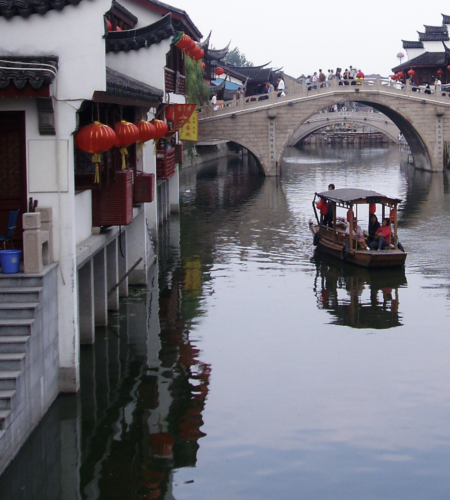Located just 18 kilometers (about 11 miles) southwest of central Shanghai, Qibao Ancient Town is a charming and well-preserved water town that offers visitors a glimpse into the city’s rich history and cultural heritage. With its cobblestone streets, traditional architecture, and tranquil canals, Qibao stands as a living museum, showcasing the lifestyle and traditions of ancient China.
Qibao’s history dates back over a thousand years to the Northern Song Dynasty (960-1127 AD). The town’s name, which means “Seven Treasures,” is derived from a legend that tells of seven treasures once hidden in the town, including a gold lotus scripture and a jade axe. Although the actual treasures have long since disappeared, Qibao has retained its historical charm and remains a significant cultural site in Shanghai.
The town is centered around a network of narrow, winding streets that are lined with traditional buildings, many of which have been carefully restored to maintain their original appearance. The architecture of Qibao reflects the styles of the Ming and Qing dynasties, with wooden facades, curved eaves, and intricate carvings. Walking through the town feels like stepping back in time, as the sights and sounds evoke a bygone era.
One of the most distinctive features of Qibao is its canals, which crisscross the town and are spanned by several ancient stone bridges. These canals were once vital for transportation and commerce, and today they add to the town’s picturesque beauty. Visitors can take a leisurely boat ride along the canals, gliding past historic buildings and under arched bridges, enjoying a peaceful perspective of the town.
Qibao is also known for its vibrant street markets, where visitors can sample a wide variety of traditional snacks and delicacies. The town’s food street is famous for its local specialties, including Qibao-style pork trotters, sticky rice dumplings (zongzi), and sweet glutinous rice cakes. These culinary delights are a major draw for both locals and tourists, offering a taste of Shanghai’s traditional flavors.
In addition to its culinary offerings, Qibao is home to several cultural and historical attractions. The Qibao Temple, one of the town’s most important landmarks, is a Buddhist temple that has been a center of worship for centuries. The temple’s serene atmosphere and beautiful architecture make it a peaceful retreat for visitors seeking spiritual reflection.
Another notable site is the Qibao Shadow Play Art Museum, which is dedicated to the traditional Chinese art of shadow puppetry. The museum offers performances and exhibits that showcase this ancient art form, which uses intricately crafted puppets to tell stories from Chinese folklore. Watching a shadow play performance in Qibao is a unique cultural experience that connects visitors with China’s rich artistic heritage.
Qibao is also known for its small museums and galleries, which highlight various aspects of the town’s history and culture. The Qibao Textile Museum, for example, provides insight into the traditional textile industry that once thrived in the region, while the Qibao Pawnshop Museum offers a glimpse into the town’s commercial past.
Despite its proximity to the bustling metropolis of Shanghai, Qibao Ancient Town retains a sense of tranquility and authenticity that makes it a popular destination for those looking to explore the city’s historical roots. Whether you’re interested in history, culture, or simply want to experience the charm of a traditional water town, Qibao offers a captivating journey into Shanghai’s past.


Comments